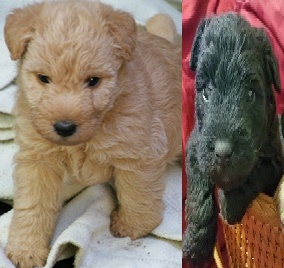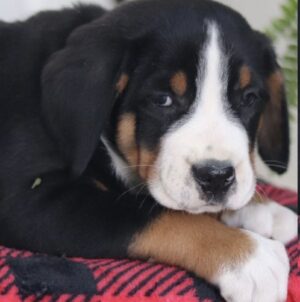Description
The Lakeland Terrier is a charming and spirited breed that captivates dog lovers with its distinctive appearance and lively personality. Originating from the Lake District of England, this breed has a rich history as a working terrier. Renowned for their intelligence, agility, and alertness, Lakeland Terriers make wonderful companions for individuals or families seeking an active and engaging pet. We will explore the physical characteristics, temperament, training needs, grooming requirements, health considerations, and tips for selecting and caring for a Lakeland Terrier, providing a comprehensive guide for those interested in this delightful breed.
1. Introduction to the Lakeland Terrier breed
1.1 Overview of the Lakeland Terrier
If you’re looking for a small dog with a big personality, meet the Lakeland Terrier! This adorable breed is known for its spunky attitude and charming looks. With their wiry coats and expressive eyes, Lakeland Terriers are hard to resist.
1.2 Popularity and recognition
While not as famous as some of their Terrier cousins, Lakeland Terriers have gained a loyal following among dog lovers. They may not have their own Hollywood movie like some other terriers, but their unique qualities have made them a favorite among families and single individuals alike.
2. Physical characteristics and appearance of the Lakeland Terrier
2.1 Size and weight
Lakeland Terriers may be small in size, but they make up for it with their boundless energy. On average, they weigh around 15 to 17 pounds and stand about 13 to 15 inches tall. Don’t let their small stature fool you though, these little dogs have big personalities!
2.2 Coat type and colors
One of the Lakeland Terrier’s standout features is their beautiful coat. It’s dense and wiry, providing protection from the elements. They come in various colors, including black, liver, red, wheaten, and grizzle. With their unique coat, they’re sure to turn heads on your daily walks.
2.3 Distinctive features and body structure
With their sturdy build and compact body, Lakeland Terriers were built to tackle tough terrain. Their deep chest and strong legs give them the agility they need for their original purpose – hunting small game. Their expressive eyes and alert ears add to their overall charming appearance.
3. History and origin of the Lakeland Terrier
3.1 Origins in the Lake District of England
The Lakeland Terrier hails from the picturesque Lake District in England. They were bred to help farmers control pests such as foxes and otters. Their small size and fearlessness made them the perfect companions on hunting expeditions.
3.2 Early roles and purposes
In addition to their hunting skills, Lakeland Terriers were also valued for their ability to protect the home from vermin. They would fearlessly chase down any unwanted critters, making them indispensable as farm dogs.
3.3 Breed development and standardization
Over time, the Lakeland Terrier’s role shifted from hunting to being devoted family pets. Breeders began focusing on their temperament and appearance, leading to the creation of the breed we know today. The breed was officially recognized by kennel clubs in the early 20th century, solidifying its place in the dog world.
4. Temperament and personality traits of the Lakeland Terrier
4.1 Energetic and lively nature
There’s never a dull moment with a Lakeland Terrier! These dogs are full of energy and love to be involved in all the household activities. Whether it’s a game of fetch or a long hike in the great outdoors, they have the energy to keep up with you.
4.2 Intelligence and trainability
Lakeland Terriers are not just all brawn – they’ve got brains too! These intelligent dogs are quick to learn and thrive with positive reinforcement training methods. Keep their minds engaged with interactive toys and puzzle games to prevent boredom.
4.3 Interaction with children and other pets
Lakeland Terriers are generally good with children, but as with any dog, supervision is necessary to ensure everyone gets along. They can be a bit territorial, so early socialization is important to help them get along well with other pets in the household.
Now that you know a little more about the Lakeland Terrier, you can appreciate their unique qualities and consider whether they would be the perfect addition to your family. With their lively personality and charming looks, they are sure to bring joy to any home.a Lakeland Terrier
8.3 Meeting the dietary needs of a Lakeland Terrier
8.4 Bonding and building a strong relationship with your Lakeland Terrier
5. Training and exercise needs of the Lakeland Terrier
5.1 Importance of early socialization and obedience training
When it comes to training a Lakeland Terrier, early socialization and obedience training are key. These little bundles of energy can be quite stubborn at times, so it’s important to start training them from a young age to establish good behavior and manners.
Socialization is crucial to ensure your Lakeland Terrier grows up to be a well-adjusted and friendly companion. Expose them to various people, animals, and environments to help them become comfortable and confident in different situations.
Obedience training will help you establish boundaries and teach your Lakeland Terrier basic commands like sit, stay, and come. Positive reinforcement techniques, such as treats and praise, work best with this breed. Just be prepared for some cheeky moments and a few adorable stubborn stares during the training process!
5.2 Exercise requirements and recommended activities
Despite their small size, Lakeland Terriers have a lot of energy to burn. Daily exercise is essential to keep them physically and mentally stimulated. A brisk walk or jog, along with some playtime in a securely fenced yard, will help them release their energy.
These terriers also excel in activities like agility, obedience trials, and even earthdog trials, where they get to showcase their natural hunting instincts. Mixing up their exercise routine with different activities can help prevent boredom and keep them happily wagging their tails.
5.3 Mental stimulation and problem-solving exercises
Lakeland Terriers are intelligent dogs that thrive on mental stimulation. Including problem-solving exercises in their routine can keep their minds sharp and engaged. Interactive toys, puzzle feeders, and hide-and-seek games are great ways to challenge their problem-solving skills.
You can also teach them new tricks and provide them with tasks that require them to think and problem-solve. Not only will this keep them mentally stimulated, but it will also strengthen the bond between you and your furry friend.
6. Grooming and maintenance requirements of the Lakeland Terrier
6.1 Coat care and grooming routines
Get ready for some hair maintenance when you welcome a Lakeland Terrier into your home. Their double-coated fur requires regular grooming to keep it looking neat and tidy. Brushing their coarse outer coat and soft undercoat a few times a week will help prevent matting and remove loose hair.
To maintain their characteristic scruffy appearance, hand stripping or professional grooming is recommended every few months. This process involves removing dead hair by hand or using a stripping knife, which helps promote new hair growth and keeps their coat healthy.
6.2 Regular maintenance tasks (nail trimming, teeth cleaning, etc.)
In addition to coat care, Lakeland Terriers also require regular maintenance tasks. Trimming their nails every few weeks is necessary to prevent them from becoming too long and causing discomfort or issues with walking.
Dental hygiene is crucial for their overall health, so regular teeth brushing is recommended to prevent dental diseases. Additionally, regular ear cleaning and routine checks for any signs of infection or irritation can help ensure their ears stay healthy.
6.3 Professional grooming considerations
If you’re not comfortable with hand stripping or maintaining your Lakeland Terrier’s coat yourself, you can opt for professional grooming services. A skilled groomer familiar with the breed will be able to tidy up their coat while preserving their unique appearance. It’s important to find a groomer who understands the specific grooming needs of the Lakeland Terrier.
7. Health considerations and common issues in Lakeland Terriers
7.1 Genetic predispositions and potential health problems
Like any breed, Lakeland Terriers have some genetic predispositions and potential health problems to be aware of. Some common issues seen in this breed include hip dysplasia, patellar luxation, and autoimmune diseases.
Regular visits to the veterinarian for check-ups and preventive care are important to catch any health issues early on. Your vet can provide guidance on appropriate vaccinations, parasite prevention, and any breed-specific health screenings.
7.2 Routine check-ups and preventive care
Routine check-ups with your vet are essential to ensure the overall health and well-being of your Lakeland Terrier. Regular vaccinations and parasite prevention, such as flea and tick control, are crucial to protect them from common diseases and parasites.
It’s also important to discuss with your vet any specific preventive care measures based on the breed’s health predispositions. Keeping up with routine care can help prolong your Lakeland Terrier’s life and keep them happy and healthy.
7.3 Tips for promoting a healthy lifestyle
To promote a healthy lifestyle for your Lakeland Terrier, provide them with a balanced diet that meets their nutritional needs. Regular exercise and mental stimulation are also important for their overall well-being.
Maintaining a healthy weight is crucial for their joint health, so avoid overfeeding and excessive treats. Make sure they have access to fresh water at all times and keep an eye out for any changes in their behavior or appetite, as these could be indicators of an underlying health issue.
8. Choosing and caring for a Lakeland Terrier as a pet
8.1 Finding a reputable breeder or rescue organization
When considering a Lakeland Terrier as a pet, it’s important to find a reputable breeder or rescue organization. This ensures that you are bringing home a healthy and well-cared-for dog.
Research local breeders or reach out to rescue organizations specializing in Lakeland Terriers. Visit the premises or ask for references to ensure they have a good reputation and prioritize the welfare of their dogs.
8.2 Preparing the home environment for a Lakeland Terrier
Before bringing a Lakeland Terrier into your home, make sure to prepare the environment to meet their needs. Ensure that your home is secure and there are no escape routes, as these terriers are known for their adventurous spirits.
Provide them with a cozy bed, toys, and a designated area for their food and water bowls. Set up a safe space where they can retreat to if they need some quiet time.
8.3 Meeting the dietary needs of a Lakeland Terrier
To meet the dietary needs of a Lakeland Terrier, opt for high-quality dog food that meets their nutritional requirements. Consult with your vet to determine the appropriate portion sizes and feeding schedule based on their age, size, and activity level.
Avoid overfeeding and be mindful of their caloric intake to prevent obesity, as excess weight can lead to various health problems. Treats can be given sparingly as rewards during training or as occasional snacks.
8.4 Bonding and building a strong relationship with your Lakeland Terrier
FAQ
1. Are Lakeland Terriers suitable for families with children?
Yes, Lakeland Terriers can be great companions for families with children. They are known to be friendly and playful, and when properly socialized and trained, they can get along well with kids. However, it’s important to always supervise interactions between young children and dogs to ensure safety for both parties.
2. Do Lakeland Terriers require a lot of exercise?
Yes, Lakeland Terriers are an energetic breed that requires regular exercise to keep them happy and healthy. Daily walks, playtime in a secure area, and mental stimulation activities are important for their well-being. Engaging them in interactive games and providing opportunities for them to burn off their energy will help prevent behavioral issues that may arise due to pent-up energy.
3. How often should I groom my Lakeland Terrier?
Lakeland Terriers have a wiry, double-coat that requires regular grooming to maintain its texture and prevent matting. Brushing their coat a few times a week and hand-stripping (removing dead hair by hand) every few months is recommended. Additionally, regular trimming of the hair around their eyes, ears, and paws is necessary. It’s also advisable to consult a professional groomer to maintain their coat’s appearance.
4. What are common health issues seen in Lakeland Terriers?
Like all dog breeds, Lakeland Terriers are prone to certain health conditions. Some common health issues observed in this breed include patellar luxation, Legg-Calvé-Perthes disease, and lens luxation. Regular veterinary check-ups, a balanced diet, and providing them with proper exercise and care can help minimize the risk of these health problems. It’s also advisable to obtain your Lakeland Terrier from a reputable breeder who conducts health screenings on their breeding dogs.
https://www.myfurryfriends.me/adopt-puppies?gad_source=1&gclid=Cj0KCQiAhomtBhDgARIsABcaYymWPIKl5kWkMXhUPEDP_ACpqS3SJgL2bsFwnU8FsbqNI0Oyu6q0w9YaAux0EALw_wcB
https://en.wikipedia.org/wiki/Puppy
https://en.wikipedia.org/wiki/Dog
https://en.wikipedia.org/wiki/Dog_breed
https://dogs.ie/
https://www.nextdaypets.com/directory/dogs/sale/
https://www.lancasterpuppies.com/
https://www.puppies.co.uk/
https://www.europuppy.com/
https://www.pets4homes.co.uk/sale/puppies/
https://www.puppyspot.com/puppies-for-sale
https://www.pups4sale.com.au/
https://petsforhomes.com.au/puppies-dogs-for-sale/
https://puppies.com/
https://www.freeads.co.uk/uk/buy-sell/pets/dogs/
https://www.gumtree.com/pets/pets-for-sale/dogs/uk/srpsearch+puppies
https://www.preloved.co.uk/classifieds/pets/dogs
https://www.marshallspetzone.com/196-pups-and-kittens
https://www.ukpets.com/dogs-for-sale
https://www.petfinder.com/dogs-and-puppies/adoption/finding-a-dog/puppies-for-sale/
https://marketplace.akc.org/puppies
https://waratahpuppies.com.au/puppies-and-dogs-for-sale/
https://petclassifieds.com/ad_category/dogs/
https://puppyfinder.com/
https://www.petmd.com/dog/general-health/teacup-dogs-puppies
https://www.thesprucepets.com/cute-teacup-dog-breeds-4587847
https://www.dailypaws.com/living-with-pets/pet-compatibility/cutest-puppies
https://www.goodhousekeeping.com/life/pets/g4531/cutest-dog-breeds/
https://www.canadapups.com/
https://www.ckc.ca/Choosing-a-Dog/PuppyList/Default.aspx
https://getapuppy.ca/
https://www.kijiji.ca/b-dogs-puppies/canada/c126l0




